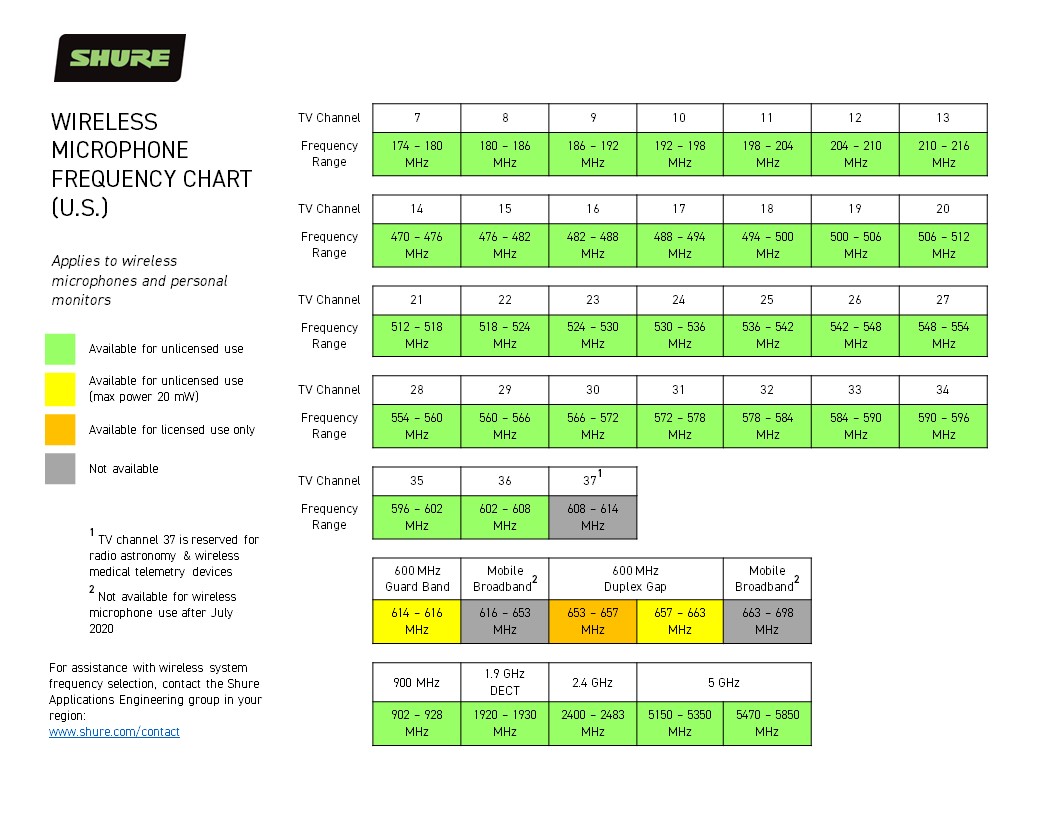Tell Me About: Wireless Microphone Frequencies

Shure Wireless Frequency Bands Chart

Wireless microphones and personal monitors (also known as in-ear monitors) transmit audio on radio frequencies. Modern systems can be adjusted to many frequencies within a specific range. Shure identifies each range as a frequency band with a letter and number, like G50 or J53. Most Shure systems are sold in multiple frequency bands that each span multiple TV channels. The frequency band of your Shure wireless system is shown on a label on the transmitter and the receiver; it may also be printed on the front panel. You can download a chart showing the available frequency bands for current and legacy Shure wireless systems (in the U.S.) by clicking the link to the right.
Wireless Microphone Frequencies Chart
All wireless microphones and personal monitors share spectrum with other types of wireless devices. There aren’t any frequency ranges that are reserved exclusively for wireless microphones. The Shure wireless frequencies chart below includes the most common frequency ranges; there are a few others that are legal but are rarely used because they have technical limitations that make them undesirable. The permitted frequency ranges, transmit power levels, and regulatory requirements vary in different countries, so wireless systems sold in one country or region may not be legal in other regions. The Wireless Microphone Frequency Chart below applies to the U.S.; check with your local Shure representative for specific frequency band information in your country.

Wireless Microphone Frequency Compatibility Charts
Even with all of the automatic scanning and frequency coordination features built into many wireless systems now, it can be handy to have the Shure wireless microphone frequency chart for the specific model that you own. Shure publishes a Frequency Compatibility Chart for most wireless systems that includes lists of every group of compatible frequencies in every frequency band that the product is available in. (Not every band shown in each chart is available in every country.) The Frequency Compatibility Chart is listed on each wireless product page on the Shure website, but here are direct links:
Frequency Compatibility Chart for the BLX wireless mic system
Frequency Compatibility Chart for the PGX-D wireless mic system
Frequency Compatibility Chart for the SLX-D wireless mic system
Frequency Compatibility Chart for the QLX-D wireless mic system
Frequency Compatibility Chart for the ULX-D wireless mic system
Frequency Compatibility Chart for the Axient Digital wireless mic system
Frequency Compatibility Chart for the PSM300 personal monitor system
Frequency Compatibility Chart for the PSM900 personal monitor system
Frequency Compatibility Chart for the PSM1000 personal monitor system
If you have questions about which Shure wireless system is right for you, or how to choose wireless microphone frequencies, contact our Applications Engineering group for assistance in any country.
Also check out these helpful resources about wireless microphone spectrum:
Why Is UHF Spectrum So Important For Wireless Microphones?
